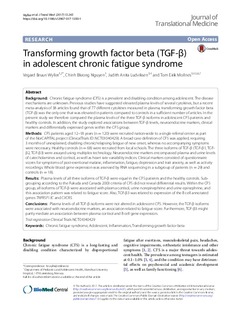| dc.description.abstract | Background
Chronic fatigue syndrome (CFS) is a prevalent and disabling condition among adolescent. The disease mechanisms are unknown. Previous studies have suggested elevated plasma levels of several cytokines, but a recent meta-analysis of 38 articles found that of 77 different cytokines measured in plasma, transforming growth factor beta (TGF-β) was the only one that was elevated in patients compared to controls in a sufficient number of articles. In the present study we therefore compared the plasma levels of the three TGF-β isoforms in adolescent CFS patients and healthy controls. In addition, the study explored associations between TGF-β levels, neuroendocrine markers, clinical markers and differentially expressed genes within the CFS group.
Methods
CFS patients aged 12–18 years (n = 120) were recruited nation-wide to a single referral center as part of the NorCAPITAL project (ClinicalTrials ID: NCT01040429). A broad case definition of CFS was applied, requiring 3 months of unexplained, disabling chronic/relapsing fatigue of new onset, whereas no accompanying symptoms were necessary. Healthy controls (n = 68) were recruited from local schools. The three isoforms of TGF-β (TGF-β1, TGF-β2, TGF-β3) were assayed using multiplex technology. Neuroendocrine markers encompassed plasma and urine levels of catecholamines and cortisol, as well as heart rate variability indices. Clinical markers consisted of questionnaire scores for symptoms of post-exertional malaise, inflammation, fatigue, depression and trait anxiety, as well as activity recordings. Whole blood gene expression was assessed by RNA sequencing in a subgroup of patients (n = 29) and controls (n = 18).
Results
Plasma levels of all three isoforms of TGF-β were equal in the CFS patients and the healthy controls. Subgrouping according to the Fukuda and Canada 2003 criteria of CFS did not reveal differential results. Within the CFS group, all isoforms of TGF-β were associated with plasma cortisol, urine norepinephrine and urine epinephrine, and this association pattern was related to fatigue score. Also, TGF-β3 was related to expression of the B cell annotated genes TNFRSF13C and CXCR5.
Conclusions
Plasma levels of all TGF-β isoforms were not altered in adolescent CFS. However, the TGF-β isoforms were associated with neuroendocrine markers, an association related to fatigue score. Furthermore, TGF-β3 might partly mediate an association between plasma cortisol and B cell gene expression. | nb_NO |

